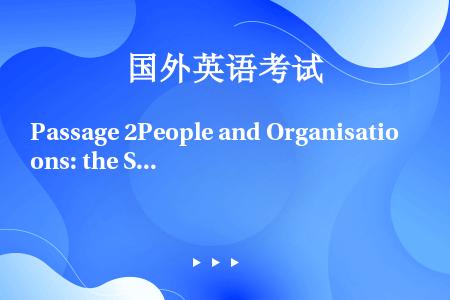 问答题
问答题
Passage 2
People and Organisations: the Selection Issue A In 1991, according to the Department of Trade and Industry, a record 48,000 British companies went out of business. When businesses fail, the post-mortem analysis is traditionally undertaken by accountants and market strategists. Unarguably organisations do fail because of undercapitalization, poor financial management, and adverse market conditions etc. Yet, conversely, organisations with sound financial backing, good product ideas and market acumen often underperform and fail to meet shareholders’ expectations. The complexity, degree and sustainment of organizational performance require an explanation which goes beyond the balance sheet and the “paper conversion” of financial inputs into profit making outputs. A more complete explanation of “what went wrong” necessarily must consider the essence of what an organization actually is and that one of the financial inputs, the most important and often the most expensive, is people.
B An organization is only as good as the people it employs. Selecting the right person for the job involves more than identifying the essential or desirable range of skills, educational and professional qualifications necessary to perform the job and then recruiting the candidate who is most likely to possess these skills or at least is perceived to have the ability and predisposition to acquire them. This is a purely person/skills match approach to selection.
C Work invariably takes place in the presence and/or under the direction of others, in a particular organizational setting. The individual has to “fit” in with the work environment, with other employees, with the organizational climate, style of work, organization and culture of the organization. Different organisations have different cultures. Working as an engineer at British Aerospace will not necessarily be a similar experience to working in the same capacity at GEC or Plessey.
D Poor selection decisions are expensive. For example, the costs of training a policeman are about 20, 000. The costs of employing an unsuitable technician on an oil rig or in a nuclear plant could, in an emergency, result in millions of pounds of damage or loss of life. The disharmony of a poor person-environment fit (PE-fit) is likely to result in low job satisfaction, lack of organizational commitment and employee stress, which affect organizational outcomes i.e. productivity, high labor turnover and absenteeism, and individual outcomes i.e. physical, psychological and mental well-being.
E However, despite the importance of the recruitment decision and the range of sophisticated and more objective selection techniques available, including the use of psychometric tests, assessment centres etc., many organisations are still prepared to make this decision on the basis of a single 30 to 45 minute unstructured interview. Indeed, research has demonstrated that a selection decision is often made within the first four minutes of the interview. In the remaining time, the interviewer then attends exclusively to information that reinforces the initial “accept” or “reject” decision. Research into the validity of selection methods has consistently demonstrated that the unstructured interview, where the interviewer asks any questions he or she likes, is a poor predictor of future job performance and fares little better than more controversial methods like graphology and astrology. In times of high unemployment, recruitment becomes a “buyer’s market” and this was the case in Britain during the 1980s.
F The future, we are told, is likely to be different. Detailed surveys of social and economic trends in the European Community show that Europe’s population is falling and getting older. The birth rate in the Community is now only three-quarters of the level needed to ensure replacement of the existing population. By the year 2020, it is predicted that more than one in four Europeans will be aged 60 or more and barely one in five will be under 20. In a five-year period between 1983 and 1988 the Community’s female workforce grew by almost six million. As a result, 51% of all women aged 14 to 64 are now economically active in the labor market compared with 78% of men.
G The changing demographics will not only affect selection ratios. They will also make it increasingly important for organisations wishing to maintain their competitive edge to be more responsive and accommodating to the changing needs of their workforce if they are to retain and develop their human resources. More flexible working hours, the opportunity to work from home or job share, the provision of childcare facilities etc., will play a major role in attracting and retaining staff in the future.
Complete the table below with words taken from the passage.
Use NO MORE THAN TWO WORDS for each answer.
Write your answers in boxes 1-4 on your answer sheet.
![]()
发布日期:2022-07-07


题王网让考试变得更简单
扫码关注题王,更多免费功能准备上线!

此试题出现在
淤血是指局部器官或组织内动脉血含量异常增多的现象。
药品生产企业需要以第二类精神药品为原料生产普通药品,应当将年度需求计划报哪个部门()
资产负债表中的“( )”项目,可以直接根据其总账科目余额直接填列。
什么是加工硬化?加工硬化产生的原因?加工硬化对塑性加工有何利弊?
患儿3岁,感冒后发热,咳嗽,一天,夜里突然憋醒并出现犬吠样咳嗽。查体:体温38.5℃,有吸气性喉鸣及轻微的吸气性软组织凹陷,听诊双肺呼吸音粗糙,无湿罗音。根据病史及体征你诊断什么病?需要与哪些疾病相鉴别?
代谢性碱中毒合并呼吸性碱中毒是一种混合型酸碱平衡紊乱类型,可见于:()
浆液性软骨膜炎的病因是()。
在借贷记帐法下,应记入有关帐户借方的是()
后勤管理程序有哪几个步骤?
关于职位说明书注意事项的陈述,正确的是( )。
非专业可以考出版资格证书吗?有哪些报考条件?
关于BEC考试有哪些备考建议?
为什么要考BEC?
有哪些学习商务英语的好方法?
商务英语考试(BEC)难不难?
都说GRE考试难,那么它究竟难在哪?
什么是GRE考试?
雅思考试在即,如何快速备考?
说说雅思考试那些事
雅思5.5相当于CET几级的水平?
Passage 2People and Organisations: the Selection Issue A In 1991, accordi...
It can be inferred from the passage that more people will ______.
According to the passage, people wearing uniforms _____.
According to the passage, people have difficulty getting to sleep because ______...
We learn from the passage that people are classified according to ______.
According to the passage, successful people concentrate on ______.
According to the passage, people wearing uniforms _____.
According to the passage, why are people more likely to tell the truth through c...
According to the passage, when people grow fond of one particular brand of a pro...
Passage 1 Some people were just born to rebel; Charles Darwin was 1 of th...

